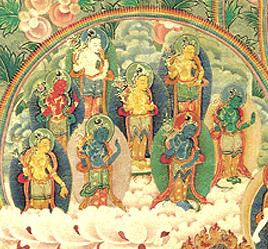Eight great bodhisattvas: Difference between revisions
Jump to navigation
Jump to search
No edit summary |
No edit summary |
||
| Line 11: | Line 11: | ||
*[[Sarvanivaranavishkambhin]], and | *[[Sarvanivaranavishkambhin]], and | ||
*[[Samantabhadra]]. | *[[Samantabhadra]]. | ||
<noinclude> | <noinclude> | ||
Each fulfils a particular role to help beings. Symbolically they represent the pure state of the [[eight consciousnesses]]. | Each fulfils a particular role to help beings. Symbolically they represent the pure state of the [[eight consciousnesses]]. | ||
| Line 40: | Line 39: | ||
===Notes=== | ===Notes=== | ||
<references/> | <references/> | ||
==Further Reading== | |||
*Jamgön Mipham, ''A Garland of Jewels'', (trans. by Lama Yeshe Gyamtso), Woodstock: KTD Publications, 2008 | |||
[[Category:Enumerations]] | [[Category:Enumerations]] | ||
Revision as of 13:19, 29 January 2009

Eight Great Bodhisattvas, or 'Eight Close Sons' (Wyl. aṣṭa utaputra; Wyl. nye ba'i sras brgyad) — the main bodhisattvas in the retinue of Buddha Shakyamuni:
- Mañjushri,
- Avalokiteshvara,
- Vajrapani,
- Maitreya,
- Kshitigarbha,
- Akashagarbha,
- Sarvanivaranavishkambhin, and
- Samantabhadra.
Each fulfils a particular role to help beings. Symbolically they represent the pure state of the eight consciousnesses.
Qualities of the Eight Bodhisattvas
Although the eight bodhisattvas or ‘close sons of the Buddha’ all possess the same qualities and powers, each one displays perfection in a particular area or activity.
- Manjushri embodies wisdom;
- Avalokiteshvara embodies compassion;
- Vajrapani represents power;
- Kshitigarbha increases the richness and fertility of the land;
- Sarvanivaranavishkambhin purifies wrong-doing and obstructions;
- Maitreya embodies love;
- Samantabhadra displays special expertise in making offerings and prayers of aspiration; and
- Akashagarbha has the perfect ability to purify transgressions.
Khenpo Chöga says:
- Among the immeasurable qualities of the Buddha, eight of his foremost qualities manifest as the eight bodhisattvas:
- 1) the personification of the Buddha’s wisdom [ye shes kyi rang gzugs] is Bodhisattva Mañjuśrī [’jam dbyangs];
- 2) the personification of the Buddha’s compassion [snying rje’i rang gzugs] appears as Bodhisattva Avalokiteśvara [spyan ras gzigs dbang phyug];
- 3) the personification of the Buddha’s power or capacity [nus pa’i rang gzugs] is Bodhisattva Vajrapāṇi [phyag na rdo rje];
- 4) the personification of the Buddha’s activity [phrin las] is Bodhisattva Maitreya [byams pa];
- 5) the personification of the Buddha’s merit [bsod nams rang gzugs] arises as Bodhisattva Kṣitigarbha [sa yi snying po];
- 6) the personification of the Buddha’s qualities [yon tan gyi rang gzugs] appears as Bodhisattva Sarvanīvaraṇaviṣkambhī [sgrib pa thams cad rnam par sel ba];
- 7) the personification of the Buddha’s blessings [byin rlabs kyi rang gzugs] arises as Bodhisattva Ākāśagarbha [nam mkha’i snying po]; and
- 8) the personification of Buddha’s aspriations [smon lam gyi rang gzugs] is manifest as Bodhisattva Samantabhadra [kun tu bzang po].[1]
Notes
- ↑ In Drops of Nectar: Khenpo Kunpal's Commentary on Shantideva's Entering the Conduct of the Bodhisattvas, www.kunpal.org, vol. 1 p.282
Further Reading
- Jamgön Mipham, A Garland of Jewels, (trans. by Lama Yeshe Gyamtso), Woodstock: KTD Publications, 2008